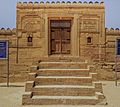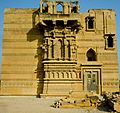Samma dynasty facts for kids
Quick facts for kids
Samma dynasty
سما راڄ
|
|||||||||
|---|---|---|---|---|---|---|---|---|---|
| 1336–1524 | |||||||||
| Capital | Thatta | ||||||||
| Common languages | Sindhi • Kutchi • Gujarati in Halar • Arabic (liturgical language) | ||||||||
| Religion | Islam • Hinduism | ||||||||
| Government | Monarchy | ||||||||
| Jam | |||||||||
| History | |||||||||
|
• Samma dynasty begins
|
1336 | ||||||||
|
• Samma dynasty ends
|
1524 | ||||||||
| Area | |||||||||
| 1500 | 500,000 km2 (190,000 sq mi) | ||||||||
| Population | |||||||||
|
• 1500
|
4000000 | ||||||||
|
|||||||||
| Today part of | Pakistan India |
||||||||
The Samma dynasty was a powerful group of Rajput rulers. They controlled a large area of the Indian subcontinent. This included Sindh, Kutch, Saurashtra, and parts of Punjab and Balochistan.
The Samma dynasty ruled from about 1351 to 1524 AD. Their main city, or capital, was Thatta. Today, Thatta is in modern Pakistan. The Samma rulers were later replaced by the Arghun dynasty.
The Samma dynasty left behind many amazing buildings in Sindh. These include grand tombs and burial sites for their kings and queens in Thatta. These structures show their rich history and building skills.
Contents
The Samma Dynasty: Rulers of Sindh
The Samma dynasty was a group of rulers who came from the Rajput community. They were known for their strength and leadership. They established a kingdom that lasted for nearly 200 years.
Where the Sammas Ruled
The Samma kingdom covered a large and important area. It included the region of Sindh, which is now in Pakistan. They also ruled over Kutch and Saurashtra, which are parts of modern-day India.
Their power reached into parts of Punjab and Balochistan. This made them a significant force in the history of the Indian subcontinent.
The Capital City of Thatta
The city of Thatta was the heart of the Samma dynasty. It was their capital city. This means it was the center of their government and culture.
Thatta was a very important city during their rule. It was a place where many grand buildings were constructed. These buildings still stand today as a reminder of the Samma dynasty's greatness.
The End of Samma Rule
The Samma dynasty's rule came to an end around 1524 AD. They were eventually replaced by another powerful group, the Arghun dynasty. However, their legacy continued through the buildings and culture they left behind.
Samma Legacy: Buildings and Culture
The Samma dynasty is remembered for its beautiful architecture. They built many impressive structures. These buildings show the artistic style of their time.
Magnificent Structures in Sindh
One of the most famous legacies of the Samma dynasty is the necropolis in Thatta. A necropolis is like a large cemetery with many tombs. The tombs of Samma rulers and important people are found there.
These tombs are not just simple graves. They are grand monuments with detailed carvings and designs. They show a mix of local and Gujarati building styles.
Important Tombs and Monuments
Many important tombs can be found from the Samma period. These include the tomb of Jam Nizamuddin II, a famous Samma ruler. His tomb has a special window called a jharoka, which shows influences from Gujarati architecture.
The Makli Necropolis is another amazing site. It contains many elaborate tombs from the 14th to 18th centuries. This site became very important during the Samma dynasty's rule.
Images for kids





